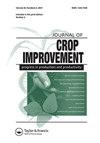Combining ability and gene action for agronomic traits and Fusarium wilt resistance in pigeonpea
IF 1.5
Q3 AGRONOMY
引用次数: 0
Abstract
ABSTRACT Combining ability analysis is fundamental in breeding programs to select desirable parents and progenies. The objectives of this study were to determine the combining ability effects, and gene action controlling agronomic traits and resistance to Fusarium wilt (FW) caused by Fusarium udum Butler in pigeonpea [Cajanus cajan (L.) Millspaugh]. Twenty-five progenies were developed from 10 selected parents using a 5 × 5 North Carolina Design II. The progenies and their parents were assessed for agronomic traits and FW resistance. The genotypes were subjected to artificial FW infection using a root dip inoculation technique to evaluate seedling resistance. ICEAP 87105 and ICEAP 01285 had significantly negative general combining ability (GCA) effects for days to 75% maturity (DTM), whereas MWPLR 22, Sauma and Mwayiwathualimi had positive GCA effects for grain yield (GYD) in a desirable direction. The study selected the best hybrids such as ICEAP 01285 × MWPLR 14 for early maturity, FW resistance and a high GYD, and TZA 5582 × ICEAP 00554, TZA 5582 × MWPLR 14, and Mwayiwathualimi × MWPLR 22 for FW resistance and a high GYD. The narrow-sense heritability values varied from 27% (number of seeds per plant) to 97% (DTM). Parental lines TZA 5582 and MWPLR 14 made strong contributions to desirable gene combinations that improved agronomic traits in the selected crosses. The new hybrids form novel breeding populations useful in improving the traits of economic importance in pigeonpea.豌豆农艺性状与枯萎病抗性的配合力和基因作用
结合力分析是选择理想亲本和后代的育种计划的基础。本研究的目的是确定乌冬镰刀菌对豌豆(Cajanus cajan(L.)Millspaugh)的配合力效应,以及控制农艺性状和抗枯萎病(FW)的基因作用。使用5×5 North Carolina Design II从10个选定的亲本中培育出25个后代。对后代及其亲本的农艺性状和FW抗性进行了评估。利用浸根接种技术对基因型进行人工FW感染,以评估幼苗的抗性。ICEAP 87105和ICEAP 01285在达75%成熟度(DTM)的天数内具有显著的负总配合力(GCA)效应,而MWPLR22、Sauma和Mwayiwathualimi对籽粒产量(GYD)具有正向的GCA效应。本研究选择了早熟、抗FW和高GYD的ICEAP 01285×MWPLR14和耐FW和强GYD的TZA 5582×ICEAP 00554、TZA 558 2×MWPLM14和Mwayiwathualimi×MWPLR22的最佳杂交种。狭义遗传力值从27%(单株种子数)到97%(DTM)不等。亲本系TZA5582和MWPLR14对所选杂交中改善农艺性状的理想基因组合做出了强有力的贡献。新的杂交种形成了新的育种群体,有助于改善豌豆的经济重要性状。
本文章由计算机程序翻译,如有差异,请以英文原文为准。
求助全文
约1分钟内获得全文
求助全文
来源期刊

Journal of Crop Improvement
Multiple-
CiteScore
3.30
自引率
7.70%
发文量
42
期刊介绍:
Journal of Crop Science and Biotechnology (JCSB) is a peer-reviewed international journal published four times a year. JCSB publishes novel and advanced original research articles on topics related to the production science of field crops and resource plants, including cropping systems, sustainable agriculture, environmental change, post-harvest management, biodiversity, crop improvement, and recent advances in physiology and molecular biology. Also covered are related subjects in a wide range of sciences such as the ecological and physiological aspects of crop production and genetic, breeding, and biotechnological approaches for crop improvement.
 求助内容:
求助内容: 应助结果提醒方式:
应助结果提醒方式:


